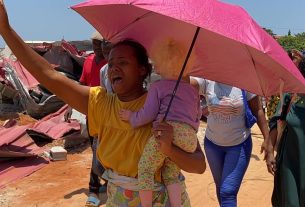[ad_1]
(Johannesburg) – The Zambian government should make comprehensive efforts to clean up the contaminated former lead mine in Kabwe, the capital of Zambia’s Central province, Environment Africa and Human Rights Watch said today. The organizations released a video in which youth activists from Environment Africa describe life in a dangerously polluted town and actions needed to remedy the situation.
Kabwe is one of the worst pollution hot spots in Africa because of contamination from a former lead and zinc mine. The mine was originally owned directly or indirectly by Anglo-American and other British colonial companies, later nationalized, and closed in 1994. But the mine’s toxic waste was never cleaned up. As a result, lead dust from its large uncovered waste dumps blows over to nearby residential areas such as Chowa, Kasanda, and Makululu, putting the health of 200,000 people at risk.
“This is Kabwe, this is our home,” said Mwelwa Lungu, a youth group member at Environment Africa. “And we are entitled to live in a clean, healthy, and sustainable environment that doesn’t make us sick.”
For the video, three youth activists from Kabwe conducted interviews about the lead contamination in Kabwe with different interlocuters. They interviewed a boy who has been exposed to lead and his parents; a geologist who has studied lead in Kabwe; and the Member of Parliament for Kabwe Central, Hon. Chrizoster Phiri.
Medical researchers estimate that over 95 percent of children living near the former mine in Kabwe have elevated lead levels in their blood. About half of them require urgent medical intervention.
Lead is a toxic metal with no safe level of exposure. It causes stunted growth, learning difficulties, memory loss, developmental delays, and many other irreversible health effects. It can also cause coma and death. Children are especially at risk. The World Health Organization lists lead as one of 10 chemicals representing a “major public health concern.”
With a World Bank loan, Zambia’s government has been undertaking some limited efforts to address the contamination in Kabwe: it has tested and treated some children and cleaned up a small number of homes and a highly polluted canal. But these measures will quickly be reversed if the source of the contamination itself – the mine waste – is not cleaned up and continues to pollute the surrounding areas.
“The Zambian government urgently needs to develop a comprehensive remediation program for the former lead mine in Kabwe,” said Juliane Kippenberg, associate child rights director at Human Rights Watch. “The government should seek technical and financial support for remediation from companies responsible for the pollution, in line with the ‘polluter pays’ principle, as well as from donor agencies and governments.”
In March 2022, President Hakainde Hichilema instructed the Ministry of Green Economy and Environment to establish a technical committee to “address and lead the process of comprehensive remediation” in Kabwe. However, the committee is still not functioning. The Ministry has put forward the vision of Kabwe as a “Green City” on top of “buried lead surfaces,” but no concrete plans have been released.
More than a year after the president issued the directive, it is vitally important for the technical committee to promptly begin work on a concrete and feasible plan for the comprehensive cleanup of Kabwe mine, Environment Africa and Human Rights Watch said.
In the video, Hon. Phiri, the Member of Parliament for Kabwe Central, urges the government “to find a lasting solution” and “clean up the waste piles at the former mine.”
In 2019, an in-depth Human Rights Watch investigation showed the harmful impacts of lead contamination on children’s rights to health, information, and education.
“As the duty bearers are running out of excuses, we young people are running out of time,” said Caleb Mulenga Bwalya from Environment Africa’s youth group. “The government needs to act now.”
[ad_2]
Source link



